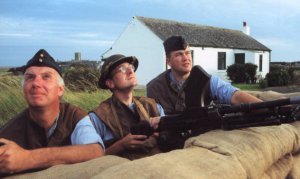Patrons:
Air Marshal Sir Ian Macfadyen
The Lieutenant Governor, His Excellency Lieutenant General Sir John Lorimer KCB DSO MBE
Enthusiasts Gunning For New Museum
 In 2002 Jim Rawson visited the Manx Aviation and Military Museum at Ronaldsway Airport.
In 2002 Jim Rawson visited the Manx Aviation and Military Museum at Ronaldsway Airport.
It’s ‘chocks away’ for a fascinating new museum which opens this month on the site of a once derelict bungalow at Ronaldsway Airport.
The Manx Aviation and Military Museum is the culmination of six months’ hard work by enthusiastic members of the Manx Aviation Preservation Society, an independent group which aims to preserve and record the Isle of Man’s aviation history, both civil and military, and particularly the Island’s involvement in WWII.
Previously the 25-strong society, formed in 1994, has been responsible for erecting two plaques dedicated to airmen and pilots who have died in over 200 air crashes on Manx soil. The society’s honorary patron is Wing Commander Clare Quill.
The latest and most ambitious project has seen its members working flat out to renovate a small uninhabited house on the airfield. Owned by the Department of Transport, the bungalow had until the 1960’s been lived in by an airport employee and had since fallen into disrepair.
Now it will form a single source of interest and education and will provide an opportunity to permanently display some of the group’s collection of military artefacts, archive photographs, documents and uniforms; previously much of the collection was stored in members’ garages and attics, only appearing during the summer months at fetes and shows.
Although their interest was initially focused on a stone barn on the Derbyhaven side of the airfield, when the offer of the house came up they were delighted. "It’s an absolutely ideal location for the museum," said press officer Dean Johnson, who also works as a pilot with Manx Airlines. "With the military history of the airport itself, which was known as RNAS Ronaldsway during WWII, and all the passing civilian air traffic today, it couldn’t be a better site."
When members of the society were first given the keys to what is now their new museum, they were immediately able to see its potential, despite the poor state of décor, a veritable jungle outside and damp plaster throughout the structure caused by condensation.
"It was a case of stripping all the damp areas out and replacing anything that was liable to further decay," said Dean. "We were able to save some items, like a WWII tannoy speaker, and we have tried to adopt an authentic paint scheme, with pale cream walls and dark green woodwork. We also had to re-plumb for toilets and a kitchen."
Working according to their own particular skills. Members of the group have concentrated on different areas of the site – fortunately one is a joiner and has been constructing glass display cases and boards organised into several sections.
The major proportion of the materials has been generously donated by local companies and individuals, including a hi-tech security system which is linked to the main airport circuit. A sponsors’ board in the entrance to the museum will bear the names of all who have helped.
"There has been a lot of pressure on members of the society as we all have jobs to go to," said Dean. "I even have my five year old son white-washing the outside wall!"
 Outside the building, a new concrete surface has formed an entrance area with seating, and tea and coffee will be available inside. There will also be a memorial garden for members of the Canadian Air Force who lost their lives on the Island during WWII – after contacting the Canadian Air Force the society received a good donation to help with the project.
Outside the building, a new concrete surface has formed an entrance area with seating, and tea and coffee will be available inside. There will also be a memorial garden for members of the Canadian Air Force who lost their lives on the Island during WWII – after contacting the Canadian Air Force the society received a good donation to help with the project.
A slit trench with duckboards has been dug out which will be used for ‘living history’ exercises. "We want people to come along and experience the conditions the armed forces would have lived in," said Dean. "We believe that when something happens it is far more memorable and a better way of education visitors, especially children. We have given talks at schools in the past with good results and groups from local schools will get priority when it comes to visiting."
"What people will see when they come to the museum is just the tip of the iceberg. It’s going to take time to rotate the large collection which the society owns and we want this to be a taster. Once we have established the museum we intend to run themed displays according to military anniversaries, showing items relating to a particular era."
While most people are aware that the Isle of Man had a role in WWII, many do not realise the full extent of activity which took place.
"Forty thousand naval personnel, 3,000 air gunners and 7,000 airmen all trained here," said Dean. "Although there are well know sites like the three airfields used for RAF training, there are lesser known sites all over the Island. We are discovering new information all the time."
Exhibition space is currently at premium, but there are future plans to extend the museum using a salvaged WWII Nissen hut.
"In the middle of trying to get the house renovated, we discovered that the hut behind Glencrutchery Road in Douglas was due for demolition," explained Dean.
"It used to serve as a Royal Navy hospital during the war and we chose it because it was in relatively good condition. It took us a day to dismantle it and we will hopefully reassemble it in the future providing we can get planning permission. It’ll suit larger items like aircraft engines and other parts."
Among the group’s most prized items are a de-activated Browning machine gun-which used to hang on the wall of a pub – a boxed set of WWII flying goggles, an RAF greatcoat and several complete uniforms. Manx Airlines also has a display panel in the room devoted to civil aviation.
In the meantime, the society continues to appeal to members of the public for any items, large or small, which pertain to military or aviation history. "We are amassing a very significant collection but we are always looking for new material," said Dean. "This history is just as important as that of thatched cottages and ancient burial sites. It’s essential that we inform future generations about what their forebears sacrificed."
The above article appeared in the October 2000 edition of MT (Manx Tails), the in-flight magazine of Manx Airlines.
By kind permission of Jim Rawson. Copyright of the Mannin Media Group Limited.
